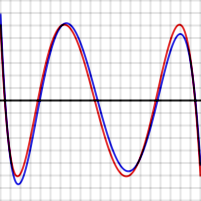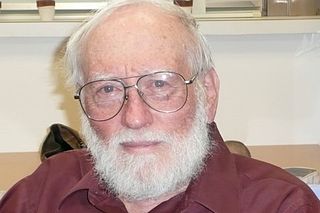The #P-complete problems form a complexity class in computational complexity theory. The problems in this complexity class are defined by having the following two properties:

In computational complexity theory, a computational problem H is called NP-hard if, for every problem L which can be solved in non-deterministic polynomial-time, there is a polynomial-time reduction from L to H. That is, assuming a solution for H takes 1 unit time, H's solution can be used to solve L in polynomial time. As a consequence, finding a polynomial time algorithm to solve a single NP-hard problem would give polynomial time algorithms for all the problems in the complexity class NP. As it is suspected that P≠NP, it is unlikely that such an algorithm exists. It is suspected that there are no polynomial-time algorithms for NP-hard problems, but that has not been proven. A simple example of an NP-hard problem is the subset sum problem.

Combinatorial optimization is a subfield of mathematical optimization that consists of finding an optimal object from a finite set of objects, where the set of feasible solutions is discrete or can be reduced to a discrete set. Typical combinatorial optimization problems are the travelling salesman problem ("TSP"), the minimum spanning tree problem ("MST"), and the knapsack problem. In many such problems, such as the ones previously mentioned, exhaustive search is not tractable, and so specialized algorithms that quickly rule out large parts of the search space or approximation algorithms must be resorted to instead.

Klaus Friedrich Roth was a German-born British mathematician who won the Fields Medal for proving Roth's theorem on the Diophantine approximation of algebraic numbers. He was also a winner of the De Morgan Medal and the Sylvester Medal, and a Fellow of the Royal Society.

In theoretical physics, quantum field theory in curved spacetime (QFTCS) is an extension of quantum field theory from Minkowski spacetime to a general curved spacetime. This theory uses a semi-classical approach; it treats spacetime as a fixed, classical background, while giving a quantum-mechanical description of the matter and energy propagating through that spacetime. A general prediction of this theory is that particles can be created by time-dependent gravitational fields (multigraviton pair production), or by time-independent gravitational fields that contain horizons. The most famous example of the latter is the phenomenon of Hawking radiation emitted by black holes.

In mathematics, approximation theory is concerned with how functions can best be approximated with simpler functions, and with quantitatively characterizing the errors introduced thereby. What is meant by best and simpler will depend on the application.
In computational chemistry, post–Hartree–Fock (post-HF) methods are the set of methods developed to improve on the Hartree–Fock (HF), or self-consistent field (SCF) method. They add electron correlation which is a more accurate way of including the repulsions between electrons than in the Hartree–Fock method where repulsions are only averaged.
Generally in scattering theory and in particular in quantum mechanics, the Born approximation consists of taking the incident field in place of the total field as the driving field at each point in the scatterer. The Born approximation is named after Max Born who proposed this approximation in early days of quantum theory development.

In physics, physical optics, or wave optics, is the branch of optics that studies interference, diffraction, polarization, and other phenomena for which the ray approximation of geometric optics is not valid. This usage tends not to include effects such as quantum noise in optical communication, which is studied in the sub-branch of coherence theory.

Spartan is a molecular modelling and computational chemistry application from Wavefunction. It contains code for molecular mechanics, semi-empirical methods, ab initio models, density functional models, post-Hartree–Fock models, and thermochemical recipes including G3(MP2) and T1. Quantum chemistry calculations in Spartan are powered by Q-Chem.

Discrete dipole approximation (DDA), also known as coupled dipole approximation, is a method for computing scattering of radiation by particles of arbitrary shape and by periodic structures. Given a target of arbitrary geometry, one seeks to calculate its scattering and absorption properties by an approximation of the continuum target by a finite array of small polarizable dipoles. This technique is used in a variety of applications including nanophotonics, radar scattering, aerosol physics and astrophysics.
In physics, a renormalon is a particular source of divergence seen in perturbative approximations to quantum field theories (QFT). When a formally divergent series in a QFT is summed using Borel summation, the associated Borel transform of the series can have singularities as a function of the complex transform parameter. The renormalon is a possible type of singularity arising in this complex Borel plane, and is a counterpart of an instanton singularity. Associated with such singularities, renormalon contributions are discussed in the context of quantum chromodynamics (QCD) and usually have the power-like form as functions of the momentum . They are cited against the usual logarithmic effects like .
The Journal of Combinatorial Theory, Series A and Series B, are mathematical journals specializing in combinatorics and related areas. They are published by Elsevier. Series A is concerned primarily with structures, designs, and applications of combinatorics. Series B is concerned primarily with graph and matroid theory. The two series are two of the leading journals in the field and are widely known as JCTA and JCTB.
Radiative equilibrium is the condition where the total thermal radiation leaving an object is equal to the total thermal radiation entering it. It is one of the several requirements for thermodynamic equilibrium, but it can occur in the absence of thermodynamic equilibrium. There are various types of radiative equilibrium, which is itself a kind of dynamic equilibrium.
Lattice density functional theory (LDFT) is a statistical theory used in physics and thermodynamics to model a variety of physical phenomena with simple lattice equations.
Yambo is a computer software package for studying many-body theory aspects of solids and molecule systems. It calculates the excited state properties of physical systems from first principles, e.g., from quantum mechanics law without the use of empirical data. It is an open-source software released under the GNU General Public License (GPL). However the main development repository is private and only a subset of the features available in the private repository are cloned into the public repository and thus distributed.
Lee Albert Rubel was a mathematician known for his contributions to analog computing.

Elliott Ward Cheney Jr. was an American mathematician and an emeritus professor at the University of Texas at Austin. Known to his friends and colleagues as Ward Cheney, he was one of the pioneers in the fields of approximation theory and numerical analysis. His 1966 book, An Introduction to Approximation Theory, remains in print and is "highly respected and well known", "a small book almost encyclopedic in character", and "is a classic with few competitors".

Anatoly Borisovich Katok was an American mathematician with Russian-Jewish origins. Katok was the director of the Center for Dynamics and Geometry at the Pennsylvania State University. His field of research was the theory of dynamical systems.
Non-relativistic quantum electrodynamics (NRQED) is a low energy approximation of quantum electrodynamics which describes the interaction of spin one-half particles with the quantized electromagnetic field.










